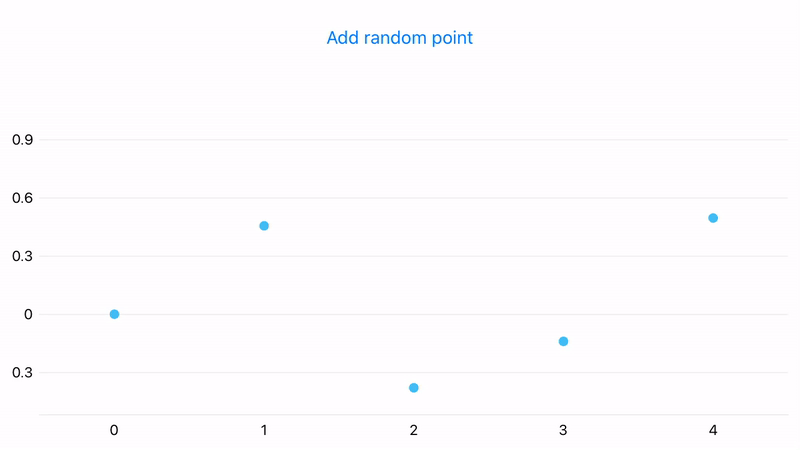Create a Custom Data Adapter
- 2 minutes to read
There are two ways to populate a chart with data:
- use the built-in DataAdapter (the workflow is described in the getting-started lessons for cartesian and pie charts);
- create a custom data adapter (for example, it is useful when the data is generated on the fly and you don’t need to store it).
This example shows how to fill a chart with random data points generated when the user clicks a button. In this case, you don’t need to store the data, so you can bind it to a ChartView using a custom data adapter.
In the code-behind MainPage.xaml.cs file, create a new class that:
- implements the IXYSeriesData interface to provide data values;
- implements the IChangeableSeriesData interface and raises the IChangeableSeriesData.DataChanged event. This event refreshes the chart series data (in the current example, it adds new data points to the chart).
using System;
using System.Collections.Generic;
using Xamarin.Forms;
using DevExpress.XamarinForms.Charts;
namespace TestApp {
public class CustomDataAdapter : BindableObject, IXYSeriesData, IChangeableSeriesData {
const int MaxDataCount = 30;
int dataCount = 0;
int offset = 0;
public event DataChangedEventHandler DataChanged;
public void Next() {
dataCount++;
DataChanged?.Invoke(this, DataChangedEventArgs.Add());
if (dataCount > MaxDataCount) {
offset++;
dataCount = MaxDataCount;
DataChanged?.Invoke(this, DataChangedEventArgs.Remove(0));
}
}
int IXYSeriesData.GetDataCount() => dataCount;
SeriesDataType IXYSeriesData.GetDataType() => SeriesDataType.Numeric;
object IXYSeriesData.GetKey(int index) => index;
double IXYSeriesData.GetNumericArgument(int index) => offset + index;
DateTime IXYSeriesData.GetDateTimeArgument(int index) => throw new NotImplementedException();
string IXYSeriesData.GetQualitativeArgument(int index) => throw new NotImplementedException();
double IXYSeriesData.GetValue(DevExpress.XamarinForms.Charts.ValueType valueType, int index) {
switch (valueType) {
case DevExpress.XamarinForms.Charts.ValueType.Value:
double argument = index + offset;
return Math.Sin(argument) * Math.Cos(argument);
}
return 0.0;
}
}
}
In the MainPage.xaml file, create a new PointSeries object, set its Data property to the custom adapter, and add it to the ChartView.Series collection.
<ContentPage
xmlns="http://xamarin.com/schemas/2014/forms"
xmlns:x="http://schemas.microsoft.com/winfx/2009/xaml"
xmlns:dxc="http://schemas.devexpress.com/xamarin/2014/forms/charts"
xmlns:local="clr-namespace:TestApp"
x:Class="TestApp.MainPage">
<dxc:ChartView x:Name="chart">
<dxc:ChartView.Series>
<dxc:PointSeries>
<dxc:PointSeries.Data>
<local:CustomDataAdapter/>
</dxc:PointSeries.Data>
</dxc:PointSeries>
</dxc:ChartView.Series>
</dxc:ChartView>
</ContentPage>
Add the button that will refresh the chart data.
<Button HorizontalOptions="FillAndExpand" Clicked="Button_Click" Text="Add random point"/>
using System;
using System.Collections.Generic;
using Xamarin.Forms;
using DevExpress.XamarinForms.Charts;
namespace TestApp {
public partial class MainPage : ContentPage {
public MainPage() {
InitializeComponent();
}
private void Button_Click(object sender, System.EventArgs e) {
PointSeries pointSeries = (PointSeries)chart.Series[0];
CustomDataAdapter dataAdapter = (CustomDataAdapter)pointSeries.Data;
dataAdapter.Next();
}
}
//..
}
Now, when a user clicks the Add random point button, a new point appears on the chart.
